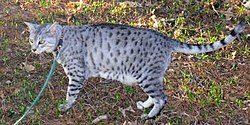| Egyptian Mau | |
|---|---|
 Black silver spotted tabby Egyptian Mau | |
| Common nicknames | Mau |
| Origin | Egypt |
| Breed standards | |
| CFA | standard |
| FIFe | standard |
| TICA | standard |
| ACFA/CAA | standard |
| CCA-AFC | standard |
| GCCF | standard |
| Domestic cat (Felis catus) | |
The Egyptian Mau is a small to medium-sized, short to medium-haired cat breed. They are one of the few naturally spotted breeds of domesticated cat. The spots of the Mau occur on only the tips of the hairs of its coat. It is considered a rare breed. [1] [2]








